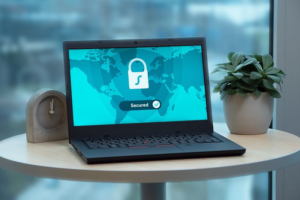Data Privacy and Cybersecurity During the Pandemic
 Innovative technology allowed experts to gain insights into the Coronavirus and track its transmission and enabled remote work during the pandemic. The increased reliance on technology and data collection to aid response efforts and allow companies and systems to run smoothly has raised concerns over how data is used and what practices can be implemented to protect it.
Innovative technology allowed experts to gain insights into the Coronavirus and track its transmission and enabled remote work during the pandemic. The increased reliance on technology and data collection to aid response efforts and allow companies and systems to run smoothly has raised concerns over how data is used and what practices can be implemented to protect it.
Remote Work & Cybersecurity
The transition to remote work has made the home a critical center of data privacy and protection. Corporations had to innovative, sometimes in real-time, to protect vulnerable systems and critical assets that are no longer under their direct oversight. Remote workers are now the first line of defense in protecting corporations’ critical data. The onslaught of cyberattacks in the past year, including the recent SolarWinds breach, have highlighted how important it is to invest in security and train employees on cybersecurity.
There are several steps remote workers and employers can take to create a more secure work environment and protect data from cyber criminals and ransomware. Some cybersecurity tips include:
- Install multi-factor authentications (MFA) and virtual private networks (VPN). VPNs are a critical tool for remote employees to securely access an organization’s IT network through an encrypted connection. The use of MFAs can elevate remote security by verifying a user’s credentials to access networks and information. These two tools are vital to secure company data and prevent hackers and cyber criminals from accessing it.
- Update software regularly. Regular software updates can help address security vulnerabilities and enhance software operation performance. Software updates can be installed either manually or automatically and are among the easiest and most effective ways to correct security problems and ensure devices are protected.
- Communicate best practices. It is important for employees to be informed of cybersecurity practices and how to protect critical assets and data. Training should cover topics such as creating strong passwords, identifying phishing emails and scams, avoiding suspicious downloads, and handling sensitive material.
Contact Tracing Privacy Concerns
In addition to a heightened awareness of data privacy at home, the pandemic has also raised privacy concerns over how data collected to fight the Coronavirus is used to inform companies and public health officials. Personal information such as location, contacts, and health status have become critical in tracking and limiting the transmission of the virus. However, the public’s reluctance to install and use contact tracing applications on their personal devices, as well as the hesitancy to share such critical information, points to the public’s growing distrust of third party use of data privacy.
As personal data continues to play a critical role in the fight against the pandemic and the protection of personal and privately-owned data becomes a growing concern, transparency and communication will be key going forward. Efforts to encourage compliance with contact tracing must include protections of privacy to enhance tracing efforts. Individuals need to feel empowered that they can manage the data information they share with third parties and that the information is safe. Only through established trust can we safeguard data, create a culture of privacy, and help overcome this pandemic.




